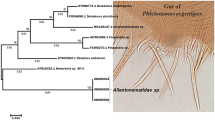Abstract
Parasites are of major clinical significance in captive primates in zoos, particularly those with direct life cycles. Oxyurid nematodes can be a persistent problem, as infection intensity and environmental contamination with infective eggs are usually high. Observations at the Basel Zoo in Switzerland have revealed that particularly black-handed spider monkeys (Ateles geoffroyi) exhibit continuous oxyurid nematode infection(s), despite regular deworming with anthelmintics. In the present study, using a molecular approach, we were able to identify the nematode (Trypanoxyuris atelis) causing this ongoing problem, and we are now evaluating a practical treatment and control regimen to tackle this parasite problem.

Similar content being viewed by others
References
Bentzel DE, Bacon DJ (2007) Comparison of various anthelmintic therapies for the treatment of Trypanoxyuris microon infection in owl monkeys (Aotus nancymae). Comp Med 57(2):206–209
Bowles J, Blair D, McManus DP (1992) Genetic variants within the genus Echinococcus identified by mitochondrial DNA sequencing. Mol Biochem Parasitol 54(2):165–173
Darriba D, Taboada GL, Doallo R, Posada D (2012) jModelTest 2: more models, new heuristics and parallel computing. Nat Methods 9(8):772
Edgar RC (2004) MUSCLE: multiple sequence alignment with high accuracy and high throughput. Nucleic Acids Res 32(5):1792–1797
Felt S, White C (2005) Evaluation of a timed and repeated perianal tape test for the detection of pinworms (Trypanoxyuris microon) in owl monkeys (Aotus nancymae). J Med Primatol 34(4):209–214
Hasegawa H (2009) Useful diagnostic references and images of protozoans, helminths, and nematodes commonly found in wild primates. In: Huffman MA, Chapman CA (eds) Primate Parasite Ecology. Cambridge University Press, Cambridge, pp 507–513
Hasegawa H, Ikeda Y, de Jesús Díaz-Aquino J, Fukui D (2004) Redescription of two pinworms from the black-handed spider monkey, Ateles geoffroyi, with reestablishment of Oxyuronema and Buckleyenterobius (Nematoda: Oxyuroidea). Comp Parasitol 71(2):166–174
Hasegawa H, Sato H, Torii H (2012) Redescription of Enterobius (Enterobius) macaci Yen, 1973 (Nematoda: Oxyuridae: Enterobiinae) based on material collected from wild Japanese macaque, Macaca fuscata (Primates: Cercopithecidae). J Parasitol 98(1):152–159
Huelsenbeck JP, Ronquist F (2001) MRBAYES: Bayesian inference of phylogenetic trees. Bioinformatics 17(8):754–755
Hugot JP (1999) Primates and their pinworm parasites: the Cameron hypothesis revisited. Syst Biol 48(3):523–546
Hugot JP, Gardner L, Morand S (1996) The Enterobiinae subfam. nov. (Nematoda, Oxyurida) pinworm parasites of primates and rodents. Int J Parasitol 26(2):147–159
Maddison W, Maddison D (2011) Mesquite: a modular system for evolutionary analysis. v2.75 edn.
Nakano T, Okamoto M, Ikeda Y, Hasegawa H (2006) Mitochondrial cytochrome c oxidase subunit 1 gene and nuclear rDNA regions of Enterobius vermicularis parasitic in captive chimpanzees with special reference to its relationship with pinworms in humans. Parasitol Res 100(1):51–57
Pinto HA, Ferreira Junior FC, Mati VL, de Melo AL (2013) Trypanoxyuris (Paraoxyuronema) lagothricis (Nematoda: Oxyuridae) in Lagothrix cana (Primates: Atelidae) from Brazil. Rev Bras Parasitol Vet 22(2):307–311
Pitts NE, Migliardi JR (1974) Antiminth (pyrantel pamoate) the clinical evaluation of a new broad-spectrum anthelmintic. Clin Pediatr (Phila) 13(1):87–94
Acknowledgments
SB and BG thank staff of Basel Zoo for their contributions. RBG acknowledges support of the Australian Research Council (ARC), Melbourne Water Corporation and from the Victorian Life Sciences Computation Initiative (VLSCI) grant number VR0007 on its Peak Computing Facility at the University of Melbourne, an initiative of the Victorian Government.
Author information
Authors and Affiliations
Corresponding authors
Rights and permissions
About this article
Cite this article
Koehler, A.V., Borel, S., Hoby, S. et al. Genetic identification of an oxyurid from a captive, black-handed spider monkey—implications for treatment and control. Parasitol Res 113, 3445–3448 (2014). https://doi.org/10.1007/s00436-014-4013-7
Received:
Accepted:
Published:
Issue Date:
DOI: https://doi.org/10.1007/s00436-014-4013-7




